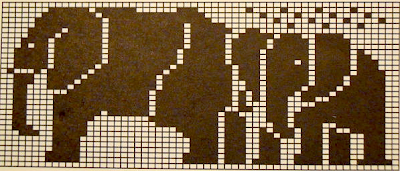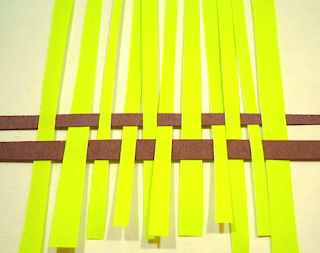Earlier this week, Frances from my fibre arts guild offered some strips of pretty green paper to anyone who wanted them. No one spoke up, so I took them, thinking I could use them to try paper weaving. I vaguely remember doing some paper weaving in nursery school, but I honestly can't remember what I made or how. Still, weaving is weaving, so I assumed that the same over-and-under technique would work with paper as well.
Although I couldn't find anything on the history of paper weaving, the technique is probably as old as paper and papyrus, which means it's been around for at least four or five millennia. Paper and papyrus are often woven to create baskets, although the most conventional use of paper weaving is in crafts and fibre arts.
 |
| For instructions on how to make this woven paper basket, click on this link. Source: http://www.jamboree.freedom-in-education.co.uk/w%27s%20craft%20 corner/paper_woven_basket.htm |
Paper weaving doesn't necessarily need to involve squared-off strips of paper. Children often learn this type of weaving with wavy strips of paper, and some paper artists weave with unusual shapes, as in the peacock basket below. Paper weaving with complicated pieces can even be used to create spheres and other dimensional objects.
 |
| Peacock basket by PaperMatrix Source: http://papermatrix.wordpress.com/category/woven-paper-hearts/ |
Paper weaving with simple strips can also be quite complex. Some artists weave strips of paper through images:
 |
| Apple Weave by Dory Kanter. Source: http://www.artworldtours.com/children.htm |
Some create patterns beyond simple one-over-one-under:
 |
| Complex patterns for paper weaving. Source: http://www.origami-resource-center.com/weaving-patterns.html |
And some make figural images:
 |
| Woven Space Invaders by Kate Lilley. Source: http://www.minieco.co.uk/geeky-weaves/ |
I was happy to come across this last one, as it suddenly occurred to me that you could probably use any charted pattern to create something with paper weaving. I decided that I would make an attempt at the pattern below, which is from The Tap Dancing Lizard by Catherine Cartwright-Jones and Roy Jones. This is the same pattern I used for my Fair Isle knitting post, but this time I'm only doing the baby elephant.
The strips of paper Frances gave me were a pretty green, so I decided to consider them as a wall of green grass through which the elephant is walking. Well, that was the idea, anyway.
For the elephant itself, I decided to use a dark brownish-purple construction paper, which I cut into thin strips as well. I made sure there would be at least an inch of extra space all the way around, to help keep things from sliding out. If the strips had been wider, I would have made the margins wider as well.
Because the pattern calls for 25 "stitches" by 30 rows, I laid out 31 pieces of green paper vertically, to allow for a few extra "stitches" to bind things together. This was a mistake. It's actually easier to lay out two horizontal lines to start, and weave the vertical strips over and under those. I was already starting to hate this activity, as things showed a marked tendency to slide around and slip out of place even with a standard over-and-under pattern.
Once I had laid in three rows of one-over-one-under weaving, I began weaving the horizontal purple weft strips over and under the green warp strips, following the chart.
There were many, many points along the way where I almost gave up, crumpled this into a ball, and threw it away. This was one of the most irritating activities I've ever tried. I don't know if it was because the strips were small, but they were constantly shifting, sliding under one another, and falling off the sides and bottom. It's hard enough to follow a graphed pattern without suddenly discovering that one of the vertical strips had been hiding under the one next to it, and that you've actually gone over three rather than two vertical strips, throwing everything off.
Even when I was done, it shifted all over the place, despite the most delicate touch I could muster, and the use of tools such as bamboo skewers. I don't know how other people do this without wanting to pitch a major hissy fit. On the other hand, paper weaving is not really meant for weaving a lot of long, carrying lines, and where I went over and under more frequently, the paper locked together better.
If you try this, here are some tips:
1. Use the same kind of paper for both warp and weft. I used one slippery paper and one rough paper, and they didn't lock well together.
2. Don't use skinny strips of paper. Mine were 0.6 cm (1/4 inch) or narrower, which required a great deal of patience and dexterity.
3. Make sure the strips are fairly uniform. I thought it would be interesting if some of them were uneven, or of different widths. It isn't.
4. Don't use a design with long areas of the same colour, as this will require you to carry horizontal strips over several vertical strips, and the weave will be loose.
5. Cut your strips far longer than you think you'll need. That way, if they decide to slide around, at least they won't fall off completely.
6. Lay in at least two rows of tight over-and-under weaving top and bottom, and on both sides, to keep the design together.
7. Glue the final result to something if you want to keep it. I put the glue on the backing paper first, spread it around, then used a kitchen spatula to lift and deposit my weaving on top. While the glue was still wet, I shoved a few errant strips back into place, sandwiched the whole thing between waxed paper, and weighted it with a big book. (I photographed the final elephant before I moved it, just in case, and all photos show the unglued elephant.)
Irritation aside, I didn't hate the final result as much as I expected I would, based on level of annoyance. And it was my own fault, anyway, for breaking many of the cardinal rules of weaving. This took far too long to make, but it looks like an elephant—and now that I've glued this little sucker to a piece of paper, it's not going anywhere.
Elephant Lore of the Day
Hard to believe, but an elephant can actually fall down a well.
In February 2012, forest rangers rescued a 100 kg (220-pound) baby elephant from a well in the Dong Nai Natural and Cultural Conservation Zone in Dong Nai Province, Vietnam. With the help of local residents, heavy rope, and a lot of muscle, the rangers managed to pull the elephant out of the well, which was about two metres (6.5 feet) deep.
Similarly, in Kerala, India in 2005, local residents realized something was wrong when they heard a female elephant trumpeting in distress. They quickly discovered that a baby elephant had fallen into a covered well, and had become stuck in the muddy bottom. When attempts to winch out the elephant with ropes failed, they dug into the side of well with shovels and pulled the baby free. To see the rescue as it unfolded, click here.
To Support Elephant Welfare
World Wildlife Fund
World Society for the Protection of Animals
Elephant sanctuaries (this Wikipedia list allows you to click through to information on a number of sanctuaries around the world)
Performing Animal Welfare Society
Zoocheck
Bring the Elephant Home
African Wildlife Foundation
Elephants Without Borders
Save the Elephants
International Elephant Foundation
Elephant's World (Thailand)
World Wildlife Fund
World Society for the Protection of Animals
Elephant sanctuaries (this Wikipedia list allows you to click through to information on a number of sanctuaries around the world)
Performing Animal Welfare Society
Zoocheck
Bring the Elephant Home
African Wildlife Foundation
Elephants Without Borders
Save the Elephants
International Elephant Foundation







Thanks for sharing informative content randomly landed on your blog but when I go through your blog I feel privileged to read your blog.
ReplyDeletehttps://www.lcrenovation.co.uk/house-extensions/
Renovations in Vauxhall